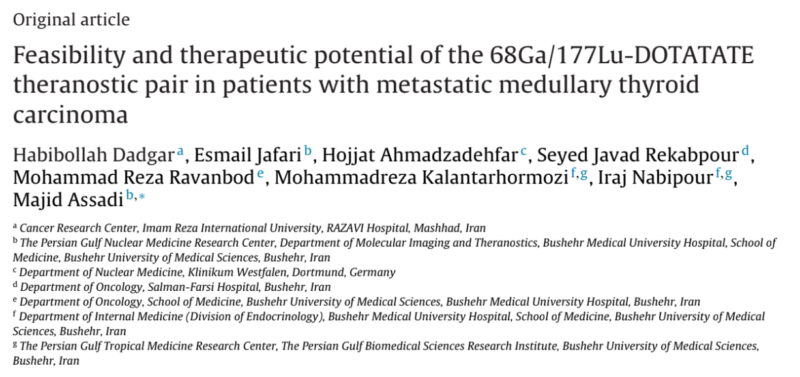An article about managing recurrent medullary thyroid cancer with 68Ga/177Lu-DOTATATE, authored by Majid Assadi et al., was published in Annals of Endocrinology:
“Radiolabeled somatostatin analogs play a crucial role in managing recurrent medullary thyroid cancer (MTC). Imaging with ⁶⁸Ga-DOTATATE PET-CT has demonstrated a high detection rate for recurrent MTC, aiding in precise tumor localization.
Furthermore, peptide receptor radionuclide therapy (PRRT) with ¹⁷⁷Lu-DOTATATE has emerged as a safe and effective therapeutic alternative, offering new hope for patients with recurrent disease.” – Majid Assadi, Founder and Director of Research Center for Nuclear Medicine and Molecular Imaging at Bushehr University and co-author of the article.
Authors: Habibollah Dadgar, Esmail Jafari, Hojjat Ahmadzadehfar, Seyed Javad Rekabpour, Mohammad Reza Ravanbod, Mohammadreza Kalantarhormozi, Iraj Nabipour, Majid Assadi.

The study aimed to evaluate the clinical efficacy of 68Ga-DOTATATE PET/CT (SSTR-PET) imaging for detecting recurrent or metastatic medullary thyroid carcinoma (MTC) and to assess the therapeutic potential of peptide receptor radionuclide therapy (PRRT) using 177Lu-DOTATATE.
The study population consisted of 20 patients with histologically confirmed MTC experiencing suspected recurrence, as indicated by elevated serum calcitonin levels post-thyroidectomy. The cohort included 10 males and 10 females with a median age of 48.5 years.
Imaging was conducted using 68Ga-DOTATATE PET/CT, and patients demonstrating positive uptake or having a Krenning score of 2 or higher on 99mTc-octreotide scintigraphy were considered eligible for PRRT.
Results showed a high detection rate using SSTR-PET, with 85% (17 out of 20) of the patients demonstrating positive results. From these 17 patients, 4 were selected for PRRT based on their imaging results.
Additionally, 2 patients with positive 99mTc-octreotide scintigraphy results (Krenning score ≥ 2) were also included in the PRRT group, resulting in a total of 6 patients undergoing treatment with 177Lu-DOTATATE.
The treatment response was assessed based on criteria categorizing patients into partial response (PR), stable disease (SD), or progressive disease (PD).
Out of the 6 patients treated with PRRT, 2 achieved partial response, 2 had stable disease, and 2 experienced disease progression. Two patients died during the follow-up period. The median overall survival (OS) for the treated patients was 19 months, with a 95% confidence interval (CI) of 5.52 to 29.48 months.
Notably, the study reported no significant toxicity associated with PRRT, as evaluated using the Common Terminology Criteria for Adverse Events (CTCAE) version 4.03.
In conclusion, the study demonstrated that 68Ga-DOTATATE PET/CT imaging provides a high detection rate for recurrent or metastatic MTC. PRRT using 177Lu-DOTATATE appeared to be a feasible and generally well-tolerated treatment option, with a subset of patients achieving partial response or stable disease.
The findings indicate that PRRT may provide clinical benefits for some patients with metastatic or recurrent MTC, although the variability in therapeutic response suggests the need for further investigation.
